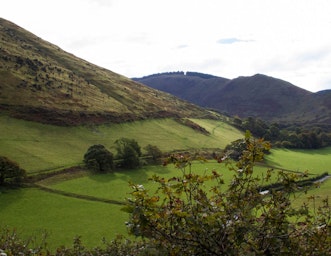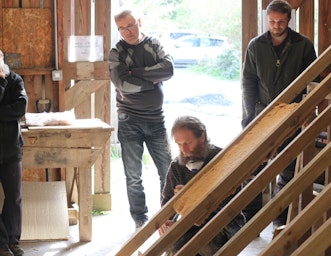
Caught on camera: the lesser horseshoe bats of CAT
November 1, 2020Home » Caught on camera: the lesser horseshoe bats of CAT
The Centre for Alternative Technology (CAT) is home to no less than five types of bat. Dulcie Fairweather gives us a glimpse of an endangered species that has found a safe haven in our Mid Wales eco centre.
Native and endangered, we consider it an absolute privilege to boast a roost of lesser horseshoe bats on site. Historically the lesser horseshoe bat had a much wider distribution across the UK, but now the total population of about 15,000 individuals is confined to Wales and western England, with a further 12,000 in western Ireland.
About the size of a plum with their wings folded, they are one of the smallest bats in the UK. Their average weight is an astonishing 4-9.5g!
Lesser horseshoes have a fleshy, horseshoe-shaped nose leaf which is related to its intricate echolocation system. They use this high frequency echolocation call to detect prey, typically emerging 20-50 minutes after sunset. If you are lucky enough to have your own bat detector, you should be able to hear a series of continuous warbles at about 110kHz. It’s important to be very quiet as lesser horseshoe bats are very sensitive to disturbance.
Bat behaviour
Like every British bat species, lesser horseshoes live complex seasonal life cycles that are dictated by the changing temperatures and availability of food throughout the year. They hibernate from September/October until April and frequently into May. While they naturally roost in caves, the rising human density into their habitats has driven them to make homes in man-made structures, including roofs, tunnels, attics and cellars. It is vital to their conservation that potential roost entrances should be left unobstructed.
As autumn approaches, bats are diligently eating as much food as possible as this enables them to put on extra body fat to sustain them through the coming winter. Aided by their manoeuvrable wings, speed and agility, they are formidable hunters. Lesser horseshoes hunt relatively close to the ground, rarely flying more than five metres above it. Their diet is comprised of flies (mainly midges), small moths, caddis flies, lacewings, beetles, small wasps and spiders. Most of the time, they snatch prey in mid-air, but can take up insects from branches, rocks and bushes.
Insect decline
Worryingly, one of the biggest threats to lesser horseshoe bats is reduced prey availability. These bats have an incredibly low body mass with small fat reserves, making them particularly vulnerable to starvation.

Recent evidence suggests that abundance of insects may have fallen by 50% or more since 1970. An overlooked apocalypse, these innumerable little creatures are far more critical for the functioning of ecosystems than the large animals that tend to attract most of our attention. Insects are intimately involved in all terrestrial and freshwater food webs. Already, UK populations of the spotted flycatcher fell by 93% between 1967 and 2016 with other once-common insectivorous birds suffering similarly.
An alarming 41% of insect species are threatened with extinction – meaning food chains are under threat as never before, and the three-quarters of human food crops which need insect pollination are also precarious.
The consequences are painfully clear; without insects, a multitude of birds, bats, reptiles, amphibians, small mammals and fish would vanish. Causes of insect declines are much debated, but most scientists believe that it is the result of a combination of man-made stresses, including habitat loss, chronic exposure to complex mixtures of pesticides and the beginnings of the impacts of climate change.
Foraging habitat
Loss of foraging habitat may also be responsible for the decline in lesser horseshoe bat populations. Lesser horseshoe bats prefer shrubland, valleys, open grassland and woodland edges. Studies have concluded that conservation measures for lesser horseshoe bats should be undertaken within 2.5 km of nursery roosts, with special consideration to the area within 600m of the roost.
Where habitat is fragmented, linear features such as hedgerows and treelines are important corridors between roosts and foraging areas. Sensitive management of their foraging habitats is vital – and it is hoped that the numbers might be increased by protecting and improving hibernation sites.
According to the Bat Conservation Trust, lesser horseshoes are particularly sensitive to disturbance, especially in their nursery and winter roosts, and these sites need specific protection.
Farmers, growers and land managers have been advised to consider and test alternative approaches to practices that pollute or strip natural capital. Whereas policymakers must incentivise restorative farming that provides public benefits and helps nature thrive at the same time as securing productivity for future generations of farmers.
_________________________________________________________________________
Helping bats where you are
As their natural habitats become scarcer, our gardens are playing a more important role in securing a future for bats.
Here are some of the ways we can lend a helping hand to our winged friends.
1. Garden greenery
Vegetation linkage is an important consideration to benefit bats. If you can plant additional trees or hedgerow close to the roost, this will help connect to bat commuting or foraging habitat. Hollow and damaged trees should always be left standing if possible. These are important for bats and other wildlife but are often ‘tidied up’ without thought for their potential value.
2. Increase the food supply
Certain garden features, such as compost heaps and ponds, are particularly good at generating the types of insect that bats like. Planting a wildlife garden can help to provide the insects that bats need, especially if there is a pond and night-scented flowers and shrubs. White or pale coloured flowers are more likely to be seen by nocturnal insects. However, as always, we implore for an end to unnecessary use of pesticides. These are chemicals created to kill – and that they do. Try to be more tolerant of insects in your garden. A few caterpillars will not cause much damage, but they could become a juicy meal for a bat.
3. Give them a home

By providing a bat box, you can give them somewhere safe to roost, raise their pups and sleep during the day. There is a multitude of designs when it comes to these boxes, from wooden boxes you can make yourself to external ready-assembled boxes and even integrated bat boxes that can be built into walls. If you do make one yourself, it’s important to use unplaned wood that has not been treated with wood preservatives.
Different bat species need different spaces, so it’s important to do some research on the type of box you’d like to put up. Lesser horseshoe bats are more typically associated with open roof voids that they can fly in. But there are many exceptions, as evidenced by records of horseshoe bats making homes in boxes.
Boxes should be put as high as possible (ideally at least 4 metres) to try and avoid predation from domestic cats on the ground. To further protect them from predation, it is recommended that boxes should be placed away from artificial light sources. As nocturnal mammals, bats are light-sensitive and adapted to low light conditions. Consideration must be made to reduce light spill close to roosting areas. On buildings, boxes should be placed as close to the eaves as possible. They prefer access through an opening that allows uninterrupted flight to the roof apex but are capable of using more inconspicuous gaps.
You can bolster your chances of success if boxes are sheltered from strong winds and exposed to the sun for part of the day. Bats need time to find and explore new homes, and it may be several months or even years before boxes have residents – be patient! Once bats have established an artificial roost where they want to live, they can return over and over again.
Please note, as bats are vulnerable to disturbance and fully protected under UK law, boxes must only be opened by a licensed bat worker. It is imperative to check if bats are in residence when building works are being planned or tree surgery is required.
Supporting bats at CAT
Here at CAT, we have an infrared camera spying on a roost in the basement area of a building on site. The location is ideal for the bats – undisturbed with a clear access point that allows continuous flight. The footage we collect gives us a fascinating insight into the world of the lesser horseshoe.
We strongly believe our habitat management is key to supporting our local population. The woodland team uses traditional methods to manage broadleaved woodland, ponds, outgrown hedgerows and tree lines, and we run courses helping others to learn these wildlife-friendly techniques.
In this way, we hope we can offer the lesser horseshoe and many more species the opportunity to thrive for generations to come.
About the author
Dulcie joined the CAT woodland team as Natural Resource and Volunteer Officer in August 2020. She has spent the first few months of her role setting up camera traps and footprint tunnels in preparation for Autumnwatch.
She has a BA (Hons) in Marine and Natural History Photography, a course that devoted heavy emphasis on environmental subjects and concerns.
- Woodland
- Gardening and Agriculture
- Building
- Nature and Wildlife
- Autumnwatch
Related Topics
Related Pages
Related news


CAT Conversations: Sandy Stevens, CAT graduate
17th April 2025
CAT stories – Nick Parsons and Mike Russell
29th January 2025
Ready for retrofit
29th January 2025
AUTUMNWATCH QUIZ
EMAIL SIGN UP
Keep up to date with all the latest activities, events and online resources by signing up to our emails and following us on social media. And if you'd like to get involved and support our work, we'd love to welcome you as a CAT member.
